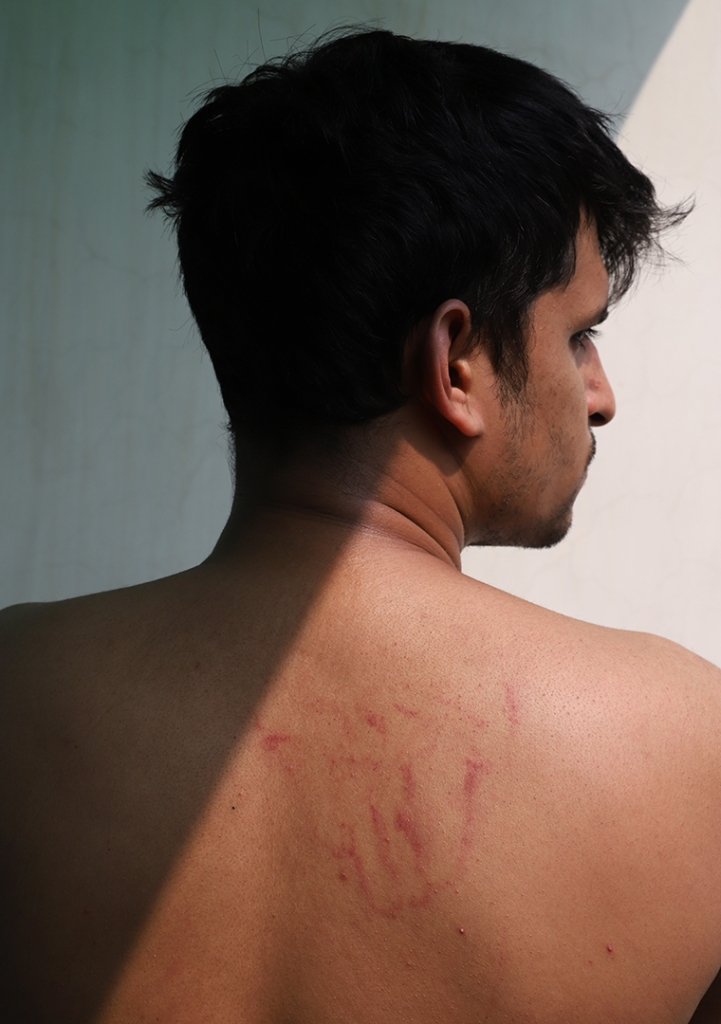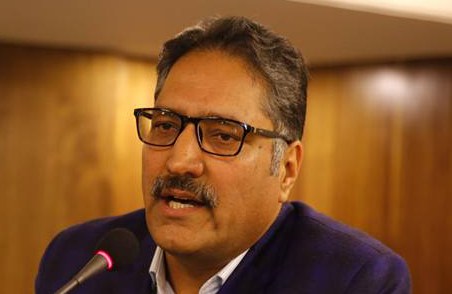“Tumhe nahi pata hai ki desh badal gaya hai?” – Griha Mantriji, we await your answer
by Geeta Seshu
The chilling account in the Caravan on the beating up of journalist Ahan Penkar on Oct 16, by Ajay Kumar, the assistant commissioner of police of Model Town, inside the premises of the police station, has this paragraph:
Other police officials participated in the assault and beatings as well. “They kept trying to threaten and intimidate us,” Penkar said. “They kept saying, ‘Your lives are over. We will charge you, there will be an FIR, you will be arrested.’” The police officials constantly used profanity against the five men held in the room. One police official told them, “Why do you all keep doing this? Tumhe nahi pata hai ki desh badal gaya hai?”—Don’t you know the country has changed?

Readers are urged to read it again. And again. This is what impunity sounds like. This is at the core of policing in New Delhi, India’s capital. It is shocking and reprehensible. It is intimidation. It provides the very real threat of the lodging of a false case against the students and activists who were protesting, legitimately so, the registration of a first-information report (FIR) in the case of the death of a 14-year-old girl who was employed as a domestic worker.
It tells them that if they make too much of a noise, they will be charged with a complaint. They will become the ‘accused’ . They can be detained, arrested, probably denied bail depending on the seriousness of the charges that will be levelled against them. They will be forced to run around to secure bail, secure surety and get lawyers to help them defend themselves against the charges, marshal whatever evidence they can and hopefully secure justice and therefore, freedom. The entire process can take years.
Welcome to the guidebook of policing in India. It’s not new, it’s not an exception. It happens all too frequently. But when a journalist is picked up and assaulted, despite repeatedly identifying as a journalist on duty, the journalist bears witness.
What was the protest about?
The attack on the journalists of The Caravan comes in the wake of the continued incarceration of journalist Prashant Kanojia in Uttar Pradesh and the arrest of journalist Siddique Kappan in Hatras.
Why was the journalist there in the first place? According to the Caravan report, a complaint had been lodged by a relative as the family suspected she had been raped and murdered by the employer. However, police had ruled her death a suicide and are stalling or refusing to lodge an FIR.
The Caravan account said:
On 16 October, Penkar arrived at the Model Town police station at around 2.45 pm to report on a protest by a small crowd of about thirty people gathered outside it, including around ten members of the teenager’s family. At the time, some members of the crowd had gone inside the station to demand that an FIR be registered immediately. When the police refused to file the report, the small crowd began to raise slogans condemning the Delhi Police.
Around thirty minutes after he had reached, Penkar was speaking to the deceased teenager’s aunt when between ten and 15 police officials, both men and women, came out of the station. They asked the protestors to disperse. When the gathered crowd refused to leave and repeated its demand for an FIR, the police officials started taking protesters and the teenager’s family members inside the station. Most of the police personnel had not donned their uniform, making it difficult for the crowd to learn their name or rank.
“I was recording the incident on my phone in one hand, with my press card of The Caravan clearly held out for the police to see on my other hand,” Penkar said. “From this point onwards, the press card never entered my wallet again, I showed it every chance I could.”
With his press card prominently displayed, Penkar recorded videos of the police taking the protestors inside the station. Then, a plain-clothes official spotted him, and pointed him out to the ACP, Ajay Kumar, who was overseeing the police personnel’s actions. Kumar ordered the personnel to take Penkar inside as well. “Isko bhi dekh lenge,” Kumar said—we will show him also. Police officials “grabbed my trousers from the back, my shirt from the front, and dragged me,” Penkar recalled. “They took my phone immediately, even before we had made it inside … The whole time, I was yelling, ‘I am a journalist, I work for The Caravan.’”
Now, Caravan has demanded that an FIR be lodged against the attack on the journalist.
Second Assault
This is the second assault on journalists of The Caravan. The magazine has been doggedly reporting on the role of the Delhi police in the February violence, which led to the death of 53 persons.
On 11 August, three journalists working with The Caravan—Shahid Tantray, Prabhjit Singh and a woman journalist, were severely beaten up and threatened with murder by a mob while reporting in Subhash Mohalla, in northeast Delhi’s North Ghonda neighbourhood. The woman staffer was sexually harassed. The journalists were following up on a report they had published a couple of days earlier, on accusations of sexual assault against Delhi Police officials by a Muslim woman who was a complainant in the Delhi violence.
The journalists had gone to the site to investigate the attacks by the police on residents of Bhajanpura. A woman complainant in a case related to the Delhi violence, had accused police officials at the Bhajanpura police station of beating and sexually assaulting her and her 17-year-old daughter on the night of 8 August. Muslim residents had assembled at the police station to seek redressal of their complaint which is what the journalists had gone to cover.
Impunity
Journalists are familiar with impunity. They have been killed, faced physical attacks and threats, intimidated and had their identity doxxed. The perpetrators, as ‘Getting away with Murder’, a study by this writer (and co-researcher Urvashi Sarkar) on the killings and attacks on journalists between 2014-19 indicates, are government agencies, security forces, political party members, religious sects, student groups, criminal gangs and local mafias.
There have been 198 serious attacks on journalists in the period between 2014-19, including 36 in 2019 alone. Journalists have been fired upon, blinded by pellet guns, forced to drink liquor laced with urine or urinated upon, kicked, beaten and chased. They have had petrol bombs thrown at their homes and the fuel pipes of their bikes cut.
The study involved a detailed follow up on 63 attacks against individual journalists. Of these, First Information Reports (FIRs) were lodged in only 25 cases. And in 18 of these, the case has not progressed beyond the registering of the FIR. In 18 other cases where journalists did file complaints (but no FIRs registered), counter complaints were filed in three cases. In 12 cases, there is no information at all and even the affected journalists do not know what happened post the attacks.
In the Aug 11 attack, the perpetrators were identified as local leaders belonging to the ruling Bharatiya Janata Party (BJP). One of them, who continually used communal slurs, identified himself as the General Secretary of the BJP.
In the case of the Aug 11 attacks against The Caravan journalists, complaints have been filed. No FIR has been registered till date. Is the police investigating the attack? Have they even made any preliminary investigation? Highly unlikely.
After all, the original story was of the inaction of the police in dealing with rioters and worse, beating up and assaulting a woman complainant and her daughter in the very premises of the police station!
Griha Mantriji, Desh badal gaya hai?”
So, take another look at the question this police officer in Model Town police station asked: “Why do you all keep doing this? Tumhe nahi pata hai ki desh badal gaya hai?”—Don’t you know the country has changed?”
The Delhi police is already under scrutiny for the manner in which its investigations into the Delhi violence have targeted victims and activists. Last week, a citizens committee of prominent retired judges and IPS officers, including Justice Madan Lokur, former Chief Justice of the Madras and Delhi high courts and former chairman, Law Commission Justice A.P. Shah, former judge of the Delhi high court Justice R.S. Sodhi, former judge of the Patna high court Justice Anjana Prakash, former Union home secretary G.K. Pillai, and former director-general of the Bureau of Police Research and Development Meeran Chadha Borwankar, have announced that they will investigate the role of the police. This is a much needed and urgent exercise.
But the question posed by the police officer in Model Town cannot wait for the committee’s findings. Delhi police, for a number of complicated historical reasons relating to the governance of the national capital, is directly under the charge of the Union Home Minister, Amit Shah. He really should answer this question.
Related



Commentaries